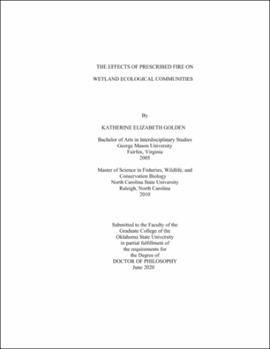| dc.contributor.advisor | Davis, Craig A. | |
| dc.contributor.advisor | Fuhlendorf, Samuel | |
| dc.contributor.author | Golden, Katherine Elizabeth | |
| dc.date.accessioned | 2021-02-22T22:24:02Z | |
| dc.date.available | 2021-02-22T22:24:02Z | |
| dc.date.issued | 2020-08 | |
| dc.identifier.uri | https://hdl.handle.net/11244/328601 | |
| dc.description.abstract | 1. Wetland Reserve Enhancement Program restorations in Oklahoma have become overrun by a native invasive species, Carex hyalinolepis, creating a structurally homogeneous condition with decreased plant diversity. We investigated the response of C. hyalinolepis to winter and summer prescribed burns in a field study. We also conducted greenhouse experiments examining the response of C. hyalinolepis shoot production and aboveground biomass to fire, simulated grazing, and flooding. Results of the field study indicated a short-term response of C. hyalinolepis to fire with C. hyalinolepis cover returning to pre-fire levels within several months of the prescribed burns. The greenhouse study results suggest a combination of fire and flooding can reduce C. hyalinolepis aboveground biomass and shoot growth. Implications of results from both the greenhouse and field study indicate that a combination of management methods may be most successful at reducing the impact of invasive species. | |
| dc.description.abstract | 2. The accuracy and historical accounts of wildfire and prescribed fire on the Texas southeastern coast may provide perspective and context on the role fire plays in these ecosystems. Using remote sensing techniques, we mapped prescribed fires on the Aransas National Wildlife Refuge between 1985 and 2013. Results indicate that the refuge is maintaining the fire dependent ecosystems with a prescribed burn program that includes a mean fire return interval between 2 and 10 years on a majority of the refuge. Quantifying the current fire regime will be useful for future management efforts on Aransas National Wildlife Refuge. | |
| dc.description.abstract | 3. The endangered Aransas-Wood Buffalo whooping crane (Grus americana) population is growing and will eventually need additional suitable habitat outside of the current refuge boundaries in order to achieve the goal of down-listing the species from endangered to threatened. Sixty years of crane location data coupled with GIS analyses were used to develop predictive models that forecast crane habitat use based on landcover and refuge management activities as well as to determine spatial patterns of cranes on the refuge. Results indicated that the amount of wetland and tidal flat habitat and the distance required for cranes to reach water and wetlands influence habitat selection. Cranes are significantly clustered along the southern coast of Aransas National Wildlife Refuge (NWR), the Lamar Unit of Aransas NWR, Matagorda and Sand Jose Islands and to the east of Aransas across the bay. The areas of high clustering correspond to crane habitat preferences. Our results indicate locations that can be protected in the future and what habitat types can be increased on and around the refuge. | |
| dc.format | application/pdf | |
| dc.language | en_US | |
| dc.rights | Copyright is held by the author who has granted the Oklahoma State University Library the non-exclusive right to share this material in its institutional repository. Contact Digital Library Services at lib-dls@okstate.edu or 405-744-9161 for the permission policy on the use, reproduction or distribution of this material. | |
| dc.title | Effects of prescribed fire on wetland ecological communities | |
| dc.contributor.committeeMember | Frazier, Amy | |
| dc.contributor.committeeMember | Twidwell, Dirac | |
| dc.contributor.committeeMember | Adams, Henry | |
| osu.filename | Golden_okstate_0664D_16850.pdf | |
| osu.accesstype | Open Access | |
| dc.type.genre | Dissertation | |
| dc.type.material | Text | |
| dc.subject.keywords | carex hyalinolepis | |
| dc.subject.keywords | prescribed fire | |
| dc.subject.keywords | whooping crane | |
| thesis.degree.discipline | Natural Resource Ecology and Management | |
| thesis.degree.grantor | Oklahoma State University | |
